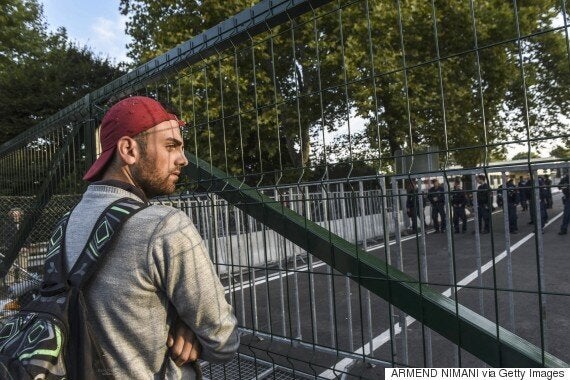Calais-style refugee camps are set to appear along the Serbian border with Hungary, it has been claimed, as a result of a new fence that aims to stop the thousands of people who have been crossing every day.
Hungary's military has spent weeks constructing the barbed wire fence, which extends the length of its border with non-EU member Serbia. More than 200,000 migrants have crossed over the boundary this year on their way to other destinations in Europe.

Refugees being turned away by the Hungarian police and trying to find alternative way to enter the country from the Serbian side of the border
Dr Jan Semmelroggen, an expert in human migration, told The Huffington Post UK the fence was "a publicity stunt" for Hungary's government, adding it would create a "bottleneck" that poorer migrants would be stuck at while those with money to pay people smugglers would be able to simply get around.
When asked how many he envisaged being caught in the bottleneck, the Nottingham Trent University academic said "tens of thousands", adding Germany's commitment to house refugees had created "a real pull factor".
He said: "We've had this migrant flow for the past four or five months across the Balkans, it's really accelerated in the last few weeks... That momentum of this new migration hasn't actually reached its peak yet so what we will see in the next couple of weeks is probably a real pile-up on the Serbian side of the Hungarian border. We'll probably see refugee camps with ten thousands of people at the heart of Europe. Winter's coming, this is going to be a very messy situation."
SEE ALSO:
The Hungary/Serbia fence runs the length of the 108 mile border. While the scale of the fence is new, it is not unprecedented to have such borders within the EU or curtailing movement within it, Dr Semmelroggen said, citing examples such as of border fences at Spanish enclaves in Morocco - a combined total of 11 miles.
Last year, around 1,000 migrants from sub-Saharan Africa rushed the fence at Melila, one of the Spanish enclaves and 400 were able to make it across onto Spanish soil. "There were waves of people, they were quite difficult to stop," the mayor said at the time.
The controversial series of fences on the US-Mexican border, which run to over 600 miles, have likewise had a limited impact on deterring undocumented migration, according to their critics.
More than nine out of 10 people who attempt to cross the border succeed, The Los Angeles Times reported in August, saying: "Fences can always be climbed over, dug under, or gone around."
When asked how much impact these border fences could be judged to have had, Dr Semmelroggen said: "None, whatsoever. [Border fences are] what creates the business model for people smugglers."
Speaking about the Hungary fence, he said: "All this is going to accomplish is drive the prices up that people can charge to bring people across the border.
"The bottom line is we can't make a fence absolutely waterproof. Our economies depend on international trade, so there needs to be some movement between countries and so long as there's openness, people will use it."
Dr Semmelroggen added: "This is really the only affect it's going to have. People smugglers are going to make a killing this winter."
The Hungary fence was ordered in June and delays over its construction led to the resignation of the Hungarian defence minister last week. Late on Monday, the first phase was finished and the border was effectively sealed later that day.

A refugee man stands looking through the fence at the Serbian border with Hungary near the town of Horgos earlier today
Dr Semmelroggen predicted it would not make anyone turn around. "They can't really go back. There's nothing to go back to. They'll just wait and hope that something will change. Those with money and means will find a way around it the ones that are really going to be punished are the poorest of the poor, who don't have the money to pay the traffickers."
Serbian minister Aleksander Vulin was on the border on Tuesday to demand the border be-reopened, as, undeterred migrants pushed against the fence trying to get through.
ITV News' Europe editor James Mates tweeted:
Syrian refugee Mohammad Baqer, who arrived at the border 20 minutes after the closure, told The Washington Post: "Now I need a new plan. When I learned this news, I felt very bad. But I think more of my people, of people in Afghanistan and in Syria back home, who now don’t really have a choice.”
